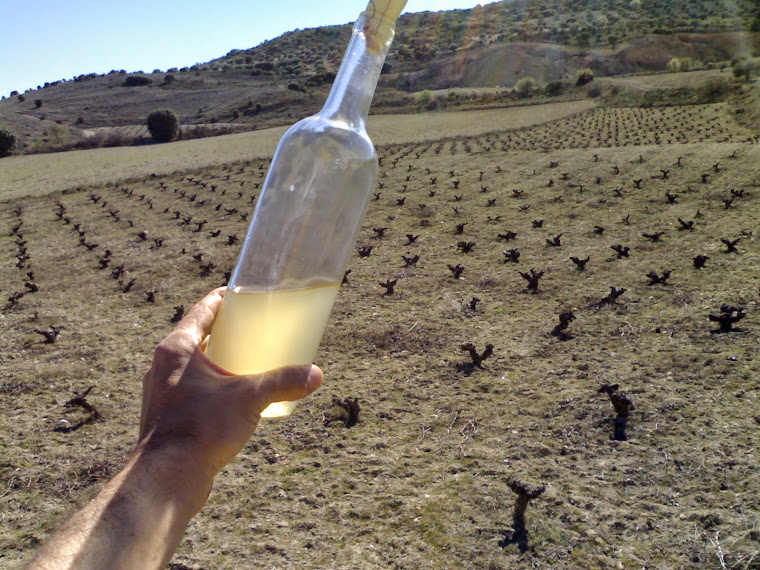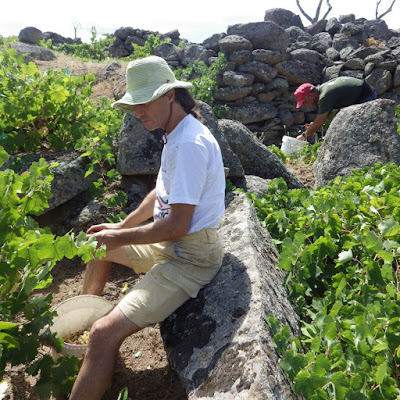Yes, it was a cloudy two days in London on 17th and 18th May, but I’m not talking about the weather, I’m talking about my wines :). In fact I seem to remember that what I saw of the sky was clear, bright and transparent, just like the wine industry would have us believe that all our wines ought to be! Ha ha!
During my two days at RAW pouring wine and chatting with visitors, I was asked many times why my wines were so cloudy. Well, I've been thinking about the cloudiness of my wines for quite some time actually, since long before RAW. Every now and then someone inevitably comments on the fact that my wines are generally rather cloudy and full of 'bits', but so many comments in such a short space of time set off the old thought processes again!!!
The short and trivial answer is of course “Because I don’t filter, fine or clarify them”.
“To fine or not to fine”, that is the real question.
There are several points in favour of not fining, and some in favour of fining or clarifying, but before going into all that, here's a nice photo of me and Isabelle Legeron, with a signed copy of her book :)
Advantages of NOT fining:
-
Saves time; and saves the expense of the fining agent. This is pretty trivial, but still, I suppose it can be considered an advantage.
-
Natural protection. All those bits and pieces (yeasts - dead or just dormant?, particles of grape skins, who knows what else?) surely contribute to protecting the wine from spoilage. That's what I intuitively feel is happening. Perhaps there are studies out there that back this up? Probably! But then again there are probably studies out there that back up the opposite theory too, no doubt! As with many other questions, I just go with my intuition here.
-
Looks good visually! There's no accounting for taste, as we all know, and some people (not many!) have actually told me that they like the cloudy, semi-transparent (or semi-opaque) look of my wines.
-
Suitable for vegans. Vegans don't drink wine that has been fined with egg-whites or fish bladders (though bentonite would be OK).
-
Extra taste. Again this is intuitive, but I believe, that if you fine or clarify or filter, you also remove lots of tasty aromatics too.
Advantages of fining:
-
Looks good visually! According to the majority of consumers. The industry standard these days is to produce a clear, transparent wine that has been fined and filtered and otherwise 'stabilized'. But what's that got to do with me? I don't sell my wines to the mass market via supermarkets, ie to consumers who only care about pretty labels and price points. I don't think the people who buy and appreciate my wines care one way or another about the visual aspect of my or any other natural producer's wine. I like to think that the reason we buy and love these natural wines is primarily to enjoy the aromas and tastes and to comment on the expression of the terroir, if any, not to gaze at them as if they were paintings or statues.
-
Stabilizes the wine. That's the industry dogma! They say that you 'have to' stabilize your wine otherwise it will turn into vinegar. But that's not my experience. I in fact have an on-going experiment running at my bodega, consisting of several bottles of my wines opened in January 2014 (during a visit from my US importer Jose Pastor) and which I have been tasting every month or so to see how they are evolving. So far (touch wood!) not one is showing any signs of turning to vinegar. But I believe that industrial large-volume producers do have to filter and fine and stabilize their wines because they are of such bad quality to start off with. It's probably perfectly true that if they didn't stabilize them, then they really would turn into vinegar pretty fast. But this is not applicable to small volume, high quality producers. IMO.
-
In fact, I believe that we have all just made a virtue of a vice, ie because basically all industrial wines have to be filtered and fined and stabilized, we have all come to accept that that that’s the ‘best’ way to make wine and that that’s the way wines ‘ought’ to look. It’s not that this processing makes the wine tastier or expresses the terroir better, or anything even remotely connected to those kinds of issues; it’s because these industrial wines have to be transported over long distances for a long time, stored for a long time in hot warehouses, and stand for a long time on supermarket shelves!
So the really real question boils down to whether the terroir is best expressed by fining or by not fining. (This is a Natural Wine Phase 2 question - see this previous post here). I don't have the answer, but I've been thinking about it, as I said. I would really welcome any thoughts and suggestions; or pointers to some literature - I'm sure this has been thought about and written about before! Nothing new under the sun here! :)
Just to keep the record straight:
Please note that not all my wines are cloudy. Some are in fact perfectly clear and transparent! But of course those wines don’t draw any comments!
The reason for this is that I generally bottle up from the top of a tank or tinaja and work my way down; so the top and middle are generally clear and transparent, while the bottom quarter generally gets more and more cloudy.
Wines can of course be clarified naturally! All it takes is gravity and time; and the colder temperatures over winter help too.
But it’s not as simple as that. It also depends on the time of the year, and the ambient temperature. Sometimes a cold snap in the bodega will make a batch of wine precipitate out the
tartrates (whatever they are!). If that happens in the bottle, like happened to some of my Sauvignon Blanc 2013 (but not all, go figure!) then the bottle will be perfectly clear and transparent, but have a shard of ‘crystal’ tartrate at the bottom. If it happens in the tank, like happened to the Airén 2014, then all the wine is clear and transparent, and the sides of the tank are encrusted with tartrates and a real bitch to clean off!
Also I bet that it has a lot to do with the atmospheric pressure on the day of bottling, and with the phase of the moon. I’ve never taken note of this before, because I’m so short of time generally that I have to bottle up when I have to bottle up, and can’t afford the luxury of waiting for the moon and/or atmospheric pressure to rise/drop. Though I would love to do be able to do so.
I would really appreciate some feedback here; I’ve been havering for months, if not years, on this matter and I don’t seem to be getting anywhere on my own!
Another thing
Another thing that was mentioned more than once during the Fair was the heat inside the main hall where the winemakers had our stands. Well, true enough, it got pretty hot in there! But to tell truth I wasn’t too bothered by it. I was able to get away from my table quite often (to answer calls of nature and to grab a quick taste of my neighbours’ wines!) as I had the help of not one but
two wine bitches this year (their term not mine!)
 |
| Winebitch#1 - You're fired! (drinking on duty) |
 |
| Winebitch#2 - Good work! |
And lastly
I also heard a few complaints that the white wines were difficult to keep properly chilled, but again I wasn’t too bothered about that either. I took the view that RAW was primarily a wine ‘tasting’ event and not purely a social event, where it is of course more enjoyable to drink your white wine chilled. At a ‘tasting’ I think it’s OK, better even, to serve your white wine slightly warmer than chilled, because that way you can appreciate all its qualities better, and of course detect any flaws easier too.
And really lastly
A nice happy anecdote, I was surprised and pleased to see the tenacious sceptic and stern critic of natural wines, Robert Joseph at the fair, who not only kindly came to my table to taste my wines but also posed for a photo of us together. I find this interesting because we have had our disagreements in the past, and quite vocal ones too, both at his own blog and at mine. But it was all boring Phase 1 natural wine issues! It seems that we’ve both moved on. I’m assuming that he didn’t come across too many “faulty” wines at the fair because he hasn’t published a post on his findings :)
 |
| Me 'n' RJ |
And really, really finally and ultimately
I did a quick search of the internet and came up with a few posts that covered RAW Fair:
- Decanter Magazine:
Natural wine movement has legs, shows RAW Fair in UK
- Jamie Goode:
RAW and the London Wine Fair
- On the Lees:
RAW Fair London
- The Holborn:
Tea and a Chat with Isabelle Legeron
- Street Eats:
RAW Wine Fair: What is Natural Wine?
- Chomping Ground:
5 Things We Learned at the RAW Fair
- The Wine Butler:
The RAW Fair
- Our Man on the Ground:
Hear us RAW at the Truman Brewery's Artisan Wine Fair
And I just have to mention also
that after all these years I may have finally and at last found myself a UK importer! Hooray! Touch wood! And hoping that all works out well! I’m actually in the process of labelling, boxing and building a pallet for the UK right now, but like any football match, it’s not over until the fat lady sings, or in my case until I see the back of a lorry driving away from the bodega with a pallet of wine safely on board! And here’s also hoping that
Otros Vinos will do a wonderful job of distributing my wines all over the UK – eventually, that is, let’s just start with London this year :)
 |
| happening at RAW |


















































